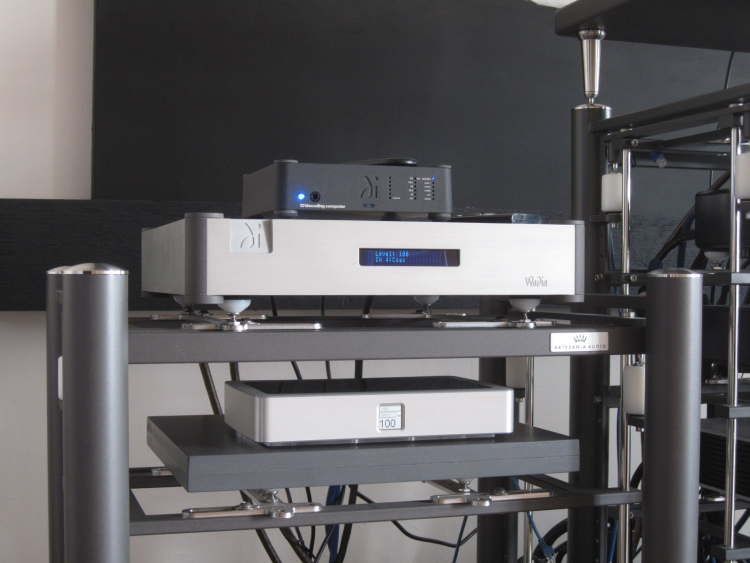
Exogal – Out of this Galaxy
Retail price in the Netherlands: 2590 euro
Exogal was founded in 2013 by audio industry veterans who have worked for some of the biggest names in the industry. The founders Jim Kinne, Larry Jacoby, Jeff Haagenstad, and Jan Larsen have set out to create products that are truly “out of this galaxy”, hence the name Exogal (Exo means “outside” or “out of” and Gal is short for “Galaxy”).
Jim Kinne was responsible for the birth of the Wadia 27 DAC and 270 CD transport and he is the technical heart and soul of Exogal. Being a long time Wadia fan, I must admit that this was what initially drew my attention to the DAC. What is quickly evident when listening to the Comet however is that it does not mimic the classical Wadia sound.

USB vs Coax
Using the Aurender N10 as a source, it turned out to make a distinct difference whether the Comet’s USB input or SP/DIF input is used. Prior to this review, I’d already established that the Aurender sounds pretty consistent across its various outputs, which is very helpful for DAC input comparisons such as this one.
The Comet has a very smooth sound, and this is further substantiated when using its Coax input. Using an AudioQuest Diamond cable, the Asynchronous USB connection makes for a noticeably tighter, more articulate sound, with better dynamic behavior and more immediate transients while the Comet’s inherent smooth character prevents the sound ever becoming overly controlled. Needless to say, continued listening was done using the Comet’s USB input.
DSD and hi-res PCM
Although I tested the Comet with some DSD material and it plays these files back flawlessly, I don’t normally put special emphasis on this format and don’t have much material to test with. Hi-Res PCM is also handled with aplomb but the majority of the listening was carried out using 44/16 WAV CD rips.
Cables
Interlinks used are the Cardas Clear, in XLR version. I also tried the T T L treated Hexlink Golden 5C XLR’s and while these sounded a little bit more outgoing in the bass and lower midrange, they also took away some of the Comet’s finer detailing and reduced treble refinement, so the Clear stayed in place for the duration of the review.
Power adapter polarity
It’s important to experiment with the orientation of the power adapter in the power outlet: one way around the sound will be softer and more rounded, the other way around tighter and more upbeat. I chose the latter.
Functionality
The Comet is a modern DAC with sleek looks and no buttons. It has a reflective grey LCD display showing input, output, volume and sample rate, but the display is not backlit and in many light situations it is impossible to read from just about any angle except when viewed straight ahead.
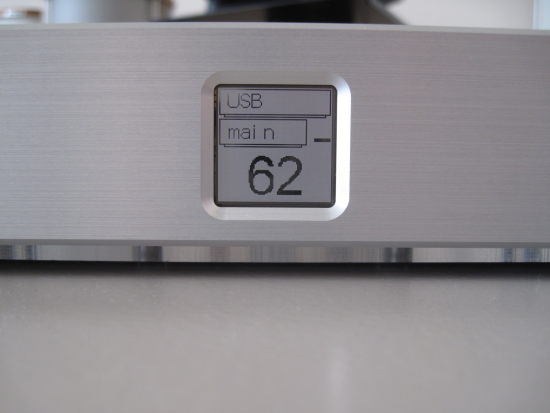
Perfectly readable display when viewed from straight ahead…
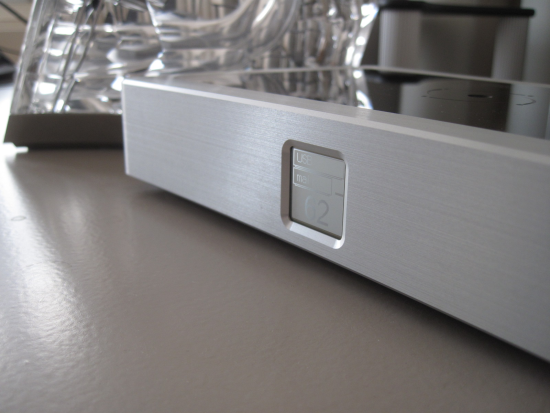
… mixed resuls from an angle…
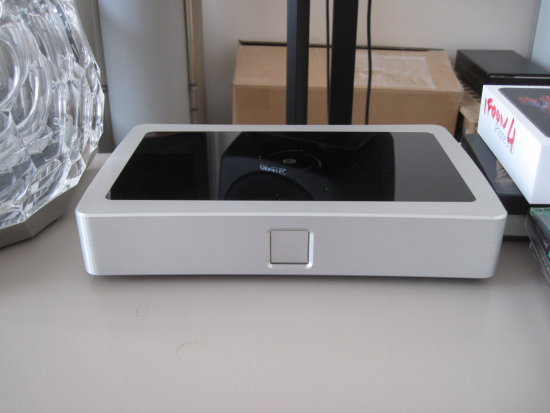
… and near impossible to read from above when strong light comes from the side.
An IR remote control is supplied, but all the DAC’s functionality can also be controlled from a mobile phone via Bluetooth. Thankfully there are no filters to choose from and there are no other settings to make whatsoever: the unit sounds the way it sounds. There are separate output stages for all 3 outputs: XLR, Cinch and headphones. A fully-fledged linear power supply is optionally available which when combined makes the Comet a Comet Plus. As standard however the Comet comes with a wall-wart switching power supply and this is how I used it.
Sound
The Comet is not a DAC that will “wow” you by blasting powerful sounds from your speakers, rather the opposite. Much like classical Jeff Rowland gear, the Comet is ever so refined, gentle and soft-spoken. Also like Rowland gear, the Comet has superb low-level resolution and is fluid to the point that one simply can no longer speak of a recognizably digital portrayal of music signals. Its sound really is 100% continuous and as smooth as a baby’s butt. It’s important to note that the Comet is not just very smooth, but also manages to not gloss over the very fine detail: its resolving power really is on par with the best I have heard. Importantly, the Comet also sounds organic and timbrally correct in equal measure.
While its detailing is never in question, perhaps as a result of a lack of distortion or edge, the Comet’s smoothness can sometimes make for a sound bordering on the polite. For systems with modern and efficient components, this will likely be a good thing, but my setup prefers a powerful source to sound its best. In this light, I find that at times the Comet could be slightly more resolute and expressive.
There is no restraint in terms of natural dynamics: music flows freely and there is excellent differentiation between soft and loud sounds, but the Comet stops just short of the kind of attack and articulation that I hear with very dynamic DACs such as Wadia in generic, the Jeff Rowland Aeris and recently the Meridian Ultra DAC.
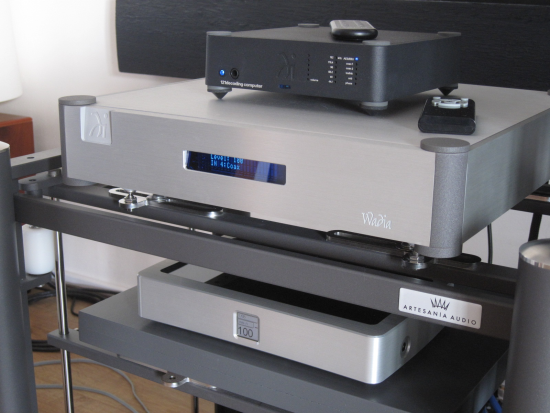
Comparisons
The Comet has an easily likable, familiar sound, mixing some of the traits of two DACs that I like a lot. Costing 5 times the Comet’s friendly price tag, the Jeff Rowland Aeris, the Comet can’t match the Aeris’ dynamic delivery, its spacious sound or its powerful bass. But judged purely on timbre, character and smoothness, the two are more similar than different. In terms of resolution and refinement, as well as for its well-behaved dynamic behavior, the Comet’s sound is reminiscent of the non-oversampling, nonfiltering EC Designs Mosaic DAC, but with an overall more powerful delivery and a fuller tonality. I find this very impressive, considering that the Comet does include digital filtering.
The Wadia 121 was recently found to be a pretty good DAC in its own right and indeed when compared directly to the Comet it still has a very appealing fullness of tonality, reminiscent of the typical classical Wadia timbre. The 121 is also quite articulate and well-focused and can sound more solid because of this, but it can also sound quite dry in comparison to the utterly fluid Comet. Also the 121’s articulate nature seems to come at the expense of spaciousness, the Comet having a considerably wider soundstage. The most obvious distinction between the Wadia 121 and the Comet is in the level of refinement. Fluidity, treble air, low level detailing: on these aspects the Comet is not only better than the Wadia 121 and Wadia 521 but actually on par with the best I have heard, and that includes DACs with stratospheric price tags.
The Comet’s dynamics are comparable to the 121’s, but on this aspect, the Comet cannot match the expressiveness of the Wadia 521. The latter sounds larger still, has a fuller, riper tonality and has a more immediate quality throughout the entire frequency band, most obvious in the bass and lower midrange.
Wadia’s trademark solid bass finally is something that is almost never matched by any DAC (the Ultra DAC being an exception) and the Comet is no exception. Don’t think that the Comet sounds lightweight though – its bass is nimble and weighty, and well-balanced.
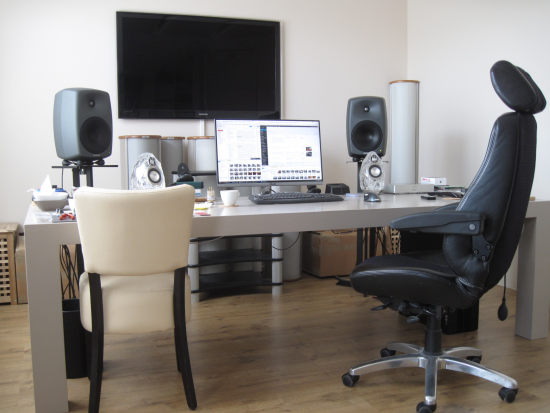
Media Room Setup
A comparison with the Rein Audio X3 DAC that I used in the Computer Audio Room aka Media Room finally before the Comet arrived shows just how good the Comet really is. In combination with the Genelec 8050 active monitors the X3 produced a tonally neutral sound with great timbre, articulate bass and with a powerful, well-focused sound. Substituting the X3 for the Comet the initial feeling is of a less forceful sound, but the Comet’s strengths slowly grow on you, largely unnoticed. With the X3 swapped back into service, it took some time to come to terms with the old sound again. The X3 has a very communicative direct sound and sounds quite “Rock ‘n Roll”, but otherwise the predominate feeling is of a stripped-to-the-bones sound, lacking color and fluidity, but most of all lacking refinement. That’s the thing with a non-edgy sound that has superb resolving power: you don’t really notice its magic until it is taken away.
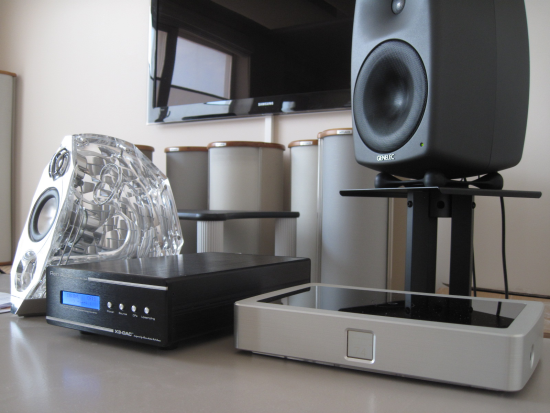
Conclusion
For its superbly refined, tonally rich, continuous and fluid sound and adding DSD support, extensive connectivity, a beautifully solid housing and Bluetooth control, this really is a pretty impressive package. Add in its realistic price tag and it becomes something of a bargain. Because the Comet sounds quite unforced and smooth, I would not advise using it in an already very relaxed sounding system, but otherwise, the Comet comes highly recommended.
External Links
Manufacturer: Exogal

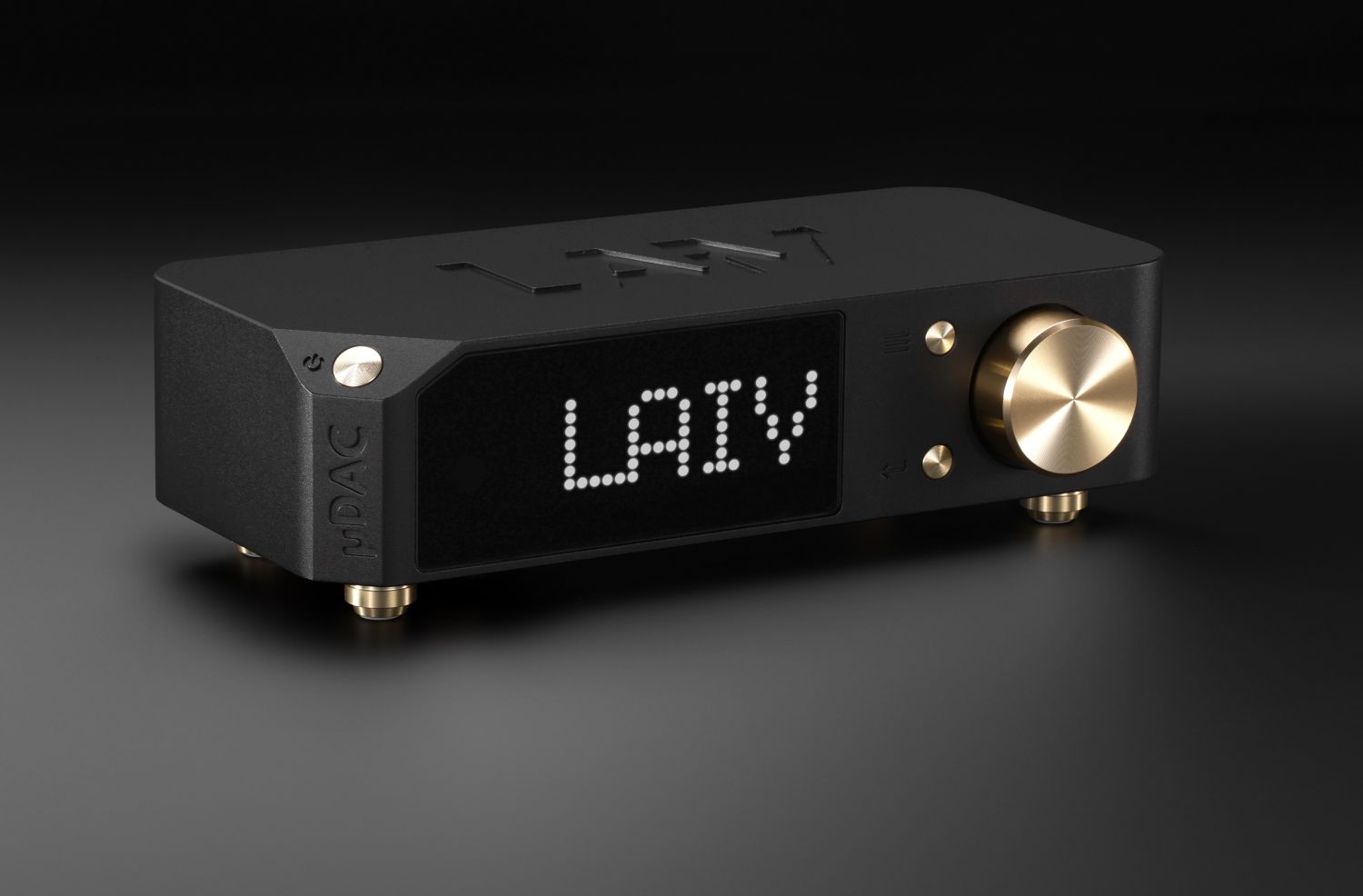






Is this dac more involving and musical compared with the Leema Elements?
I would say that the Comet is more transparent and more finely layered, and slightly more articulate and upbeat. The Elements DAC is more relaxed and tonally even fuller. It’s a matter of perspective, but I find both portrayals to be very musical. Although neither are Wadia-like in terms of punch and slam, you could say that the Exogal is perhaps a little more exciting.
Christiaan,
you really should have tested it with the bigger power-supply as the Comet+.
I think that the shortcomings you mentioned then were all gone. I’d give it a try i I were you. Regards
Hi Bernd, No doubt you are right about this. I can confirm the importance of power supplies in general: they really have a major influence on the sound. I just did not try it with the Comet. That said, I really like how the Comet sounds already with its standard switched power supply, its transparency, refinement and level of detail is really excellent. My feeling is that it will sound fuller and more sonorous, but not necessarily more powerful or dynamic with a linear power supply. Nevertheless if the opportunity arises to assess the linear power supply then I’ll update the review.
Dear Christiaan,
Can you please describe the Comet soundstage: layering, focus, etc. As commented time ago I am looking for a DAC to replace the Accuphase board DAC 40 on my E460 integrated amp & PMC 26 in order to open the soundstage.
Thanks in advance,
Alex
Although I have not compared Comet and DAC40, the Comet will definitely be more refined. I have a feeling that it will probably also have a slightly wider soundstage with more precise imaging but not necessarily a deeper, or more enveloping soundstage, which I think you are after.
Thank you Christiaan. Luckily I have found the root cause for the “compressed soundstage”. I will comment on the Accuphase review.
Hello Christiaan,
You know the Mark Levinson sound pretty good, so how does the Comet hold against the ML360s or a 390s? Is the Levinson sound wider, deeper? Or are the equally?
You need to distinguish between the 390S and the 360S. While they have a similar sound, there are differences. The 390S has a Delta/Sigma DAC and the 360S a multibit DAC. Both components when used as a DAC sound smooth but the 390S sounds quite a bit more relaxed and more free-flowing. On the other hand the 360S is more accurate and has better low level resolution, but also sounds more temporally restrained, a bit more technical if you will. Especially when used in CD player mode, the 390S sounds incredibly involving. This made me sell the 360 and 360S and keep the 390S.
The Exogal Comet is very different from both Levinsons, cleaner, brighter, perhaps a little bit more transparent and maybe also slightly more resolving. However, the Levinsons have a more sonorous sound with heavier bass and a more creamy midrange. Soundstage-wise I think the Levinsons sound wider, especially the 390S, but not necessarily more precise in terms of image focus. Do note that I never tried the optional linear power supply with the Comet. This might change things for the better. Probably this will give the Comet a richer sound.
BTW not having them side by side anymore I need to dig from memory but I’d say if anything the 390S probably had a deeper soundstage whereas the Comet is more forward.
Hmm i think I’m going with a 360s had it in my system and liked it. The soundstage wasn’t as big as with my spectral but more detailed.
Why is it that in case of an upgrade 39 to an 390s it’s apparently less wanted than a factory 390s?
The exogals are pretty cheap 2nd hand so i’ll get one down the road and do a test side to side.
39’s are older than 390S so chances are that the transport is more worn. Same goes for the capacitors etc. That’s why originals are valued more. CD Pro 2 mech is still available but not cheap.
Hello Christiaan,
I like the fluid, undistorted and free flowing qualities of nos-dacs. But at the same time my Metrum HEX sounds a little boring and uninvolving and I miss dynamics.
Now I am looking for something as fluid and undistorted as a nos-dac but with more dynamics/authority and warmth. I always thought the Comet would be a nice dac but never heard it.
Would you still reccommend this dac or are there current better options in your opinion?
I have an Concentra II integrated and I play with apogee centaur-like speakers.
Thanks in advance
Hi Ruben, I can understand what you are saying about the Metrum. I felt the same in relation to the Pavane. I still consider the Comet a very fine DAC in its price class. Indeed, it will offer much of what you value in a NOS DAC along with more impact and dynamics. Something else you could consider is the Denafrips Venus which has NOS-like refinement, air and fluidity along with superb resolution. The downside compared to the Exogal is that it is leaner in balance and has a slightly synthetic timbre, although I know that not everyone is as sensitive to this as I am.
Hello Christiaan,
Thank you for your quick reply. I read your review of the Denfrips Venus and it sounds really good. I will put this one on my shortlist for sure.
In addition: last week I borrowed a heavily modded Tentlabs B-dac from a friend. It sounds a lot more dynamic and involving than my Metrum. But I believe it also has this slightly synthetic timbre that you’re talking about, or digital edge, as I like to call it. I hear it especially on vocals and strings, and it sounds quite unnatural to me. I will give Denafrips a try anyway. Thanks again.
Hi Ruben, Hope you find your ideal match! PS when I refer to synthetic, I mean the timbre, not edge or harshness. It’s about tonality, for instance if a wood instrument really sounds like the wood that it is made of, or slightly “synthesized”.
Hello Christiaan,
I read your review (and others) of the Denafrips Venus and it looks really interesting. Although I think that the ‘slightly synthetic timbre’ as you call it, could be a no-go for me. At the moment I borrowed a heavily modded Tentlabs B-dac and it sounds really good in terms of bass, placement and fluidity. It really is a fun-dac, but at the same time it also has this, as I call it, digital edge. Especially on vocals and strings. When you listen longer, it just doesn’t sound natural. I’m not sure if we are talking about the same thing though.
I am really curious about how an Exogal or the Dinafrips will perform in my setup. You were also really enthusiastic about the Audio GD R8 dac. How would you rank/compare that one to the Exogal and Denafrips?
In (more or less) this pricerange I also found good reviews on the Schiit Yggdrasil, Chord Hugo TT and RME ADI-2 DAC. I am really interested if you have any experience with these and what you think of them.
Sorry for all those questions 🙂
Hi Ruben, The Exogal sure does not sound edgy nor synthetic. I like it a lot! The AGD R8 is also really great, especially for the money. It sounds much in line with the Aqua Formula xHD and Denafrips Venus but has more natural timbre than the latter. It also has a slightly fuller tonality but it remains a very pure-sounding NOS DAC and so it’s not as full or voluptuous in the bass as many filtered DACs. I personally feel that NOS is the purest way to go but it does need to fit in your system. As always, it is a matter of finding the ideal balance. The best filtered DAC that I know right now is the Mola Mola Tambaqui. The interesting part is that it uses Delta/Sigma conversion (albeit with proprietary processing) it sounds very close to the Aqua and other NOS DACs while offering other sonic advantages such as high purity but no leanness and a smooth sound without masking detail. Oh, coming in second, the Bricasti M1 Classic could also be a great candidate.
Thanks again!
Hello Christiaan,
I have to choose all in one between Exogal Comet plus and SOtM sdp-1000… on second hand market they are available in the same price tag. I need DAC, preamp and analog input for my MM/MC step-up transformer. I will connect it to my ML432 by balanced . Source will be ML39 and SOtM sms-200.Which would be your choice as you reviewed both, maybe some alternative?
Thanks in advance!
Hi Adrian, I would opt for the Exogal. The SOtM might be a little bit more refined but I’ve found that the unit is not very stable. The Exogal on the other hand has very solid engineering. In this price range, the Denafrips Venus is also interesting but it doesn’t offer all the functionality that you need.
Hi Christiaan. My Exogal Comet has gone into standby mode. I have pressed every button on the remote to try to wake it up but with no effect. Unfortunately it comes with no instructions. Do you know the answer, please. Thanks Keith
Hi Keith, could it be something as trivial as the remote control’s battery being depleted? Have you tried the iPhone app?
I uploaded the manual and 2 other docs via WeTransfer and had the link here for a week but it is now expired. Hope you had the chance to download.
Hi,
I’ve taken a chance on an Exogal comet. I’m trying to find a DAC that does realistic timbre. With my modest turntable setup with SUT and LOMC tones are richly saturated, detailed and the timbre is realistic. So a drum hit sounds like its a drum being hit right in my listening room rather than a recording. With the right mastering, pressing etc. I’ve found all digital sources, CD players, DAC’s don’t even get close to the sound i get from records in terms of realistic portrayal ot timbre…. Does the Comet get closer to this “realistic” timbre?
It depends on which aspects of sound reproduction you liken to realism. The truth is that electronic systems simply cannot 100% reproduce authenticity. So, you have to know what precisely to look for. Realism, for me, is fast and unrounded transient behavior and the absence of blur. A realistic timbre, for me, is the absence of a synthetic, plasticky sheen. For others, realism may lie in fluidity, flow, warmth, saturation, and the absence of hardness, edge, or dryness. I think the Comet is great, but it does not sound like a typical vinyl setup. Now, vinyl certainly does not need to sound warm, liquid, or deeply saturated. Part of what many consider the warmth of “vinyl” sound is rounding and coloration, which can result from insufficient care taken in setup and record cleaning. I’m not saying it doesn’t sound nice, but is typical vinyl actually realistic? Of course, opinions on this will vary, and I don’t want to start a debate, merely to provide an alternative narrative to use when comparing vinyl to digital. Vinyl, done right, can and often will sound more realistic than typical digital, certainly in the same price bracket. Timbre seems easier for analog to get to sound convincing than for digital, or any active electronic component, really. But there are many DACs that I feel also provide realistic timbre. Transient attack can actually be great with vinyl (and the right recording), and many music servers reduce this very aspect, in spite of having theoretically much higher dynamic range. There are other factors at play that influence the feeling of immediacy and snap. Digital can do this, the Comet can too, but it is very easily lost with the wrong server, cables, or bad power. Vinyl is much more resilient in that regard. If you’re looking for the relaxed lushness, liquidity, and tonal saturation of a typical analog setup, you may find some redeeming qualities in classic Philips and Marantz CD players, but at the cost of lower resolution and much less realistic transient behavior. However, most modern DACs do not sound like that. Ok, this was far more text than I should have written… anyway, hope it helps!
Thanks for that reply!.
This sums up what i’m looking for in my digital replay –
“Realism, for me, is fast and unrounded transient behavior and the absence of blur. A realistic timbre, for me, is the absence of a synthetic, plasticky sheen.”